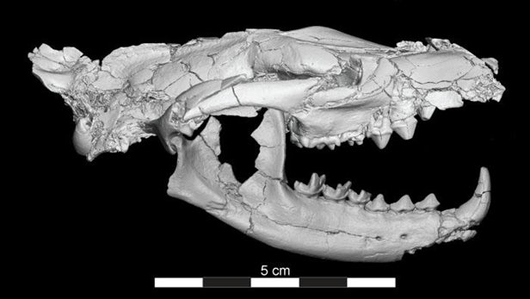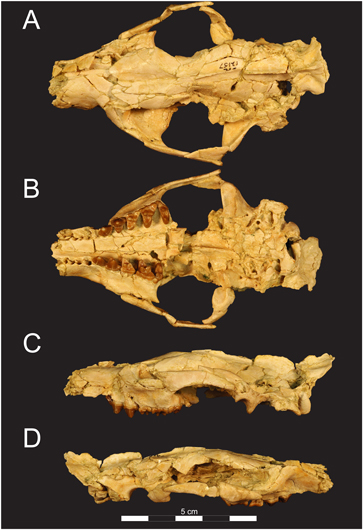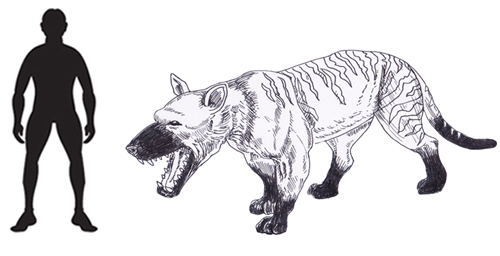New Species of Hyaenodont from Egypt Described
Masrasector nananubis – From the Late Eocene of Egypt
Everything Dinosaur highlights the discovery of a new species of hyaenodont from Egypt (Masrasector nananubis).
If people are asked to name a meat-eating mammal, you can expect to get answers such as tiger, bear or lion. Those of us with more of a domestic outlook on life might mention cats and dogs, but for a significant portion of the Cenozoic, sometimes referred to as the “Age of Mammals”, the Carnivora, the Order to which bears, cats and dogs belong, did not get a look in. Prior to the evolution of many types of recognisable carnivorous mammal alive today, other types of mammals filled the role of hypercarnivores*.
The Hyaenodonta
One such group was the Hyaenodonta. A diverse clade of carnivorous mammals that filled a variety of roles in terrestrial ecosystems in both the New and the Old World. Writing in the on-line academic journal PLOS One, scientists from Ohio University and the University of Southern California have published details of a new species of Yorkshire terrier-sized hyaenodont, the beautifully preserved skull and jaws are helping palaeontologists to understand more about the evolution and phylogeny of this extinct group, a group that has no close relatives alive today.
The Skull and Jaws of a Newly Identified Species of Hyaenodont
Picture credit: PLOS One
Masrasector nananubis – Named after a God of Ancient Egypt
The Late Eocene deposits of the Fayum Depression (Egypt), have provided scientists with a substantial number of mammal fossils, including a number of hyaenodonts, the latest to be added to this list is Masrasector nananubis. It has been classified as member of the Hyaenodontidae, specifically part of the teratodontine clade, a poorly known group which are distinguished from other hyaenodonts by subtle differences in the shape of their skulls, jaws and teeth.
Masrasector translates as “the Egyptian slicer”, a reference to the large molars (carnassials). The species or trivial name honours Anubis, the jackal-faced Egyptian god of mummification. The premolars and molars of Masrasector have larger grinding surfaces when compared to other hyaenodonts. The researchers have speculated that Masrasector nananubis may have supplemented its diet of small mammals, amphibians, reptiles and insects by feeding on fruit and nuts. This suggests that, like other members of the Teratodontinae clade, it may not have relied on meat consumption as much as other hyaenodonts that were hypercarnivorous. It has been suggested that M. nananubis may have been mesocarnivorous*.
Views of the Skull of Masrasector nananubis
Picture credit: PLOS One
An Important Fossil Discovery
It may be true that hyaenodont fossils are known from Africa, North America, Asia and Europe and that the genus Hyaenodon survived for around twenty-six million years, the longest temporal spam known for a fossil mammal, but the discovery of these Masrasector fossils is still very significant. The fossils comprise largely complete skulls, jaws, and parts of the skeleton, making them one of the most complete known African hyaenodonts from the Paleogene found to date. Previously, researchers only had isolated bones and teeth fragments to work with, frustrating palaeontologists as they attempt to piece together the family tree representing the Hyaenodontidae.
The fossils come from a dig site (locality 41) in the Fayum Depression, the well-consolidated clays have been dated to the Late Priabonian of the Eocene (approximately 34 million years ago). The Masrasector material represents some of the oldest fossils known for this type of hyaenodont.
Important Fossils (Masrasector nananubis)
Commenting on the importance of the fossils, corresponding author for the study, Matthew R. Borths (Department of Biomedical Sciences, Heritage College of Osteopathic Medicine, Ohio University), stated:
“These fossils might be the oldest and most complete ever discovered, but there is still much that remains to be discovered as the fossils of other members of this group are fragmentary. Masrasector can be used as a cornerstone of character development for exploring the evolution and diversity of other hyaenodontids.”
An Illustration of the Giant Hyaenodont (H. gigas)
Picture credit: Everything Dinosaur
To view models and replicas of hyaeonodonts (whilst stocks last) and other prehistoric creatures: Wild Safari Figures and Models.
Matthew went onto add:
“Hyaenodonts were the top predators in Africa after the extinction of the dinosaurs. This new species is associated with a dozen specimens, including skulls and arm bones, which means we can explore what it ate, how it moved, and consider why these carnivorous mammals died off as the relatives of dogs, cats, and hyenas moved into Africa.”
Explaining Terms
Hypercarnivore* an animal which has at least 70% of its diet made up of meat.
Mesocarnivore* an animal which has around 50% to 70% of its diet made up of meat.
The scientific paper: “Craniodental and Humeral Morphology of a New Species of Masrasector (Teratodontinae, Hyaenodonta, Placentalia) from the Late Eocene of Egypt and Locomotor Diversity in Hyaenodonts” by Matthew R. Borths and Erik R Seiffert published in PLOS One.
Visit Everything Dinosaur’s website: Everything Dinosaur.




